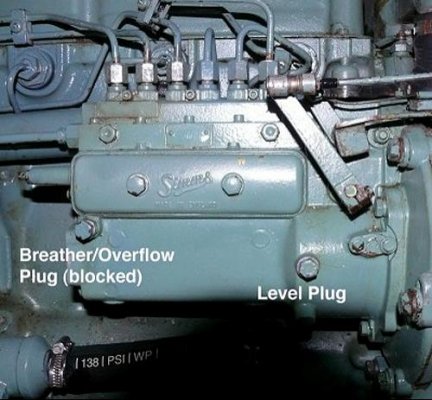Troy---
If the FL80 uses a four-cylinder version of the Simms pump and it has the same breather/overflow arrangement as the FL120's pump, I see no reason why removing the banjo connection and pipe and drilling a small breather hole in the fill plug wouldn't be okay to do.
The reason people do this on the FL120's Simms pump is that because of the engine's rearward slant, the pump tends to burp oil out of the breather tube and it ends up in the engine pan or bilge. Also, on a pump that dilutes its oil at least a little bit--- which is just about all of them--- as the oil level comes up a bit, more of it goes out the breather pipe.
What Bob Smith at American Diesel advised me to do was to remove the pipe and its banjo fitting and then get a stainless nut just big enough to slip over the hollow bolt in place of the banjo fitting. The stainless nut covers the hole in the bolt and a soft washer (aluminum, brass) goes on each side of the nut to keep oil from seeping out from around it. Bob advises to keep the hollow bolt rather than replace it because its length is matched to whatever is inside the pump to ensure clearance.
The second part of the mod is to drill a tiny breather hole in the large oil fill bolt on top of the pump. Bob recommends driling the hole in the center of the bolt head down in the screw slot.
He told me that American Diesel makes these modifications to every pump they get for overhaul if it has not already been modified.
While I don't see any reason you couldn't do the same thing to an FL80 I would strongly suggest you contact American Diesel to confirm this. When it comes to diesel engines and diesel engine components, none of which are cheap to replace, I believe in confirming everything with the pros, not just taking a fellow boater's advice as gospel
PS-- If you're asking about the mod Rollsdoc mentioned, which is converting a Simms pump to use the engine's crankcase oil instead of having its own isolated lube oil supply, I've only seen a photo of this arrangement on a CAV version of the Simms pump-- I don't know exactly where holes are drilled, pipes are fastened, etc.* American Diesel would be the best source for that information.
-- Edited by Marin at 12:02, 2007-12-14
